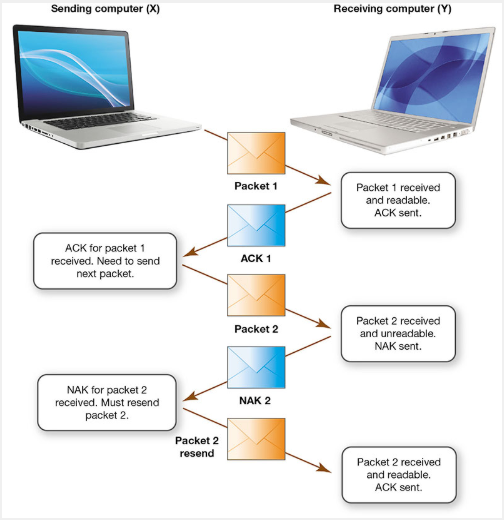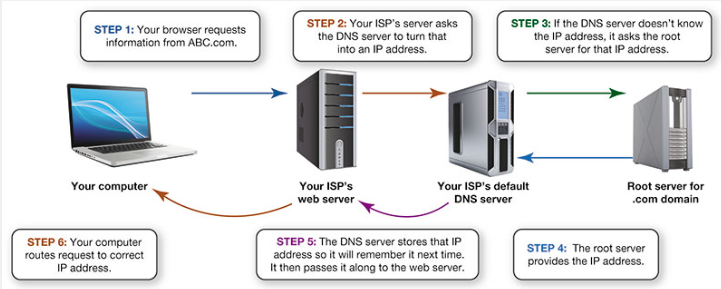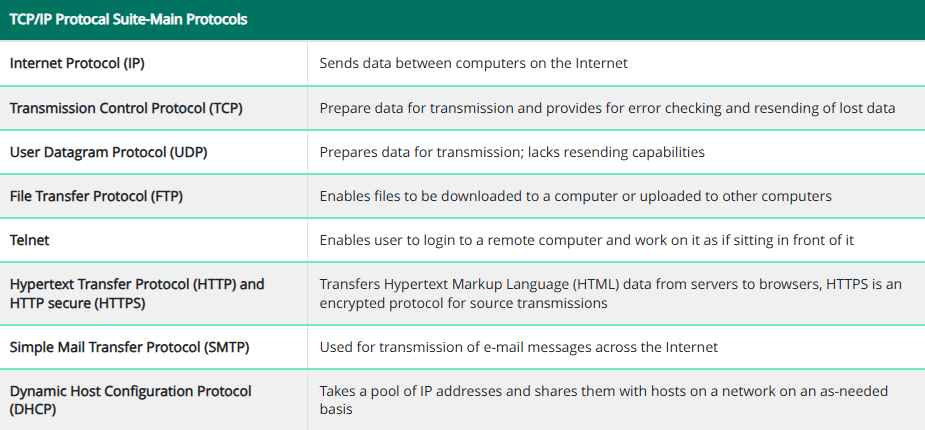Understanding IP Addresses, Domain Names, and Protocols
1/31
There's no tags or description
Looks like no tags are added yet.
Name | Mastery | Learn | Test | Matching | Spaced |
|---|
No study sessions yet.
32 Terms
Circuit switching
A dedicated connection is formed between two points (such as two people on telephones), and the connection remains active for the duration of the transmission.
Packet Switching
Packet switching is the communications methodology that computers use to transfer data.
It replaced circuit switching, the communications methodology used on devices like the telephone. In circuit switching, a dedicated connection is formed between two points (for example, between two people on telephones) and the connection remains active for the duration of the transmission. This method of communication is extremely important when communications must be received in the order in which they were sent (such as in telephone conversations).
Packet switching does not require a dedicated communications circuit to be maintained. With packet switching, data is broken into smaller chunks (called packets or data packets) and sent over various routes at the same time. When the packets reach their destination, they are reassembled by the receiving computer.
Packet Components
At a minimum, all packets must contain:
An address to where the packet is being sent,
Reassembling instructions if the original data was split between packets, and
The data that is being transmitted.
Packet Transmission
Sending a packet is like sending a letter. Say you are sending a very long letter to your aunt. The letter is too big to fit in one envelope, so you mail three envelopes. Each one includes your aunt’s address, a return address, and different pages of the letter. Each envelope may not find its way to San Diego by the same route, but they will all eventually arrive in your aunt’s mailbox. Your aunt will then put the pages of the letters in order and read it.

Computer protocol
A set of rules for exchanging electronic information.
Connectionless protocol
Does not require any type of connection to be established or maintained between two computers that are exchanging information.
Connection-oriented protocol
Requires two computers to exchange control packets, thereby setting up the parameters of the data exchange session, before sending packets that contain data.
Domain name
Simply a name that takes the place of an IP address, making it easier for people to remember.
A domain name is simply a name that takes the place of an IP address, making it easier for people to remember it. Yahoo.com and AOL.com are domain names.
Domains are organized by level:
The portion of the domain name farthest to the right (after the dot) is the top-level domain (TLD). Examples of TLDs include .com, .edu, and .org.
Within the top-level domains are many second-level domains. For example, in the .com top-level domain, there are many second-level domains such as Amazon.com, Google.com, and Microsoft.com.
Dotted decimal number (or dotted quad)
A typical IP address is expressed as follows: 197.169.73.63
DNS (domain name system)
When you enter the URL in your browser, your computer must convert the URL to an IP address. To do this, your computer consults a database that is maintained on a DNS (domain name system) server that functions like a phone book for the Internet.
How does your computer know the IP address of another computer? It uses a database maintained on a domain name system (DNS), which functions like a phone book for the Internet.

Static and Dynamic addressing
IP addresses are either assigned statically or dynamically.
When a computer has a static addressing, it means that the IP address never changes. Static IP addresses are most likely assigned manually by a network administrator.
When a computer has a dynamic addressing, it means that your ISP assigns your computer a temporary IP address from an available pool of IP addresses each time you log on to the Internet.
Dynamic addressing
Your computer is assigned an address from an available pool of IP addresses; more common addressing.
Static addressing
Means that the IP address for a computer never changes and is most likely assigned manually by a network administrator or ISP.
Dynamic host configuration protocol (DHCP)
Dynamic addressing is normally handled by the dynamic host configuration protocol (DHCP), which belongs to the TCP/IP protocol suite. DHCP takes a pool of IP addresses and shares them with hosts on the network on an as-needed basis.
Dynamic addressing is normally handled by the dynamic host configuration protocol (DHCP). When a user logs on to an ISP’s server, the DHCP server assigns that user an IP address for the duration of the session. These temporary IP addresses may or may not be the same from session to session.
Because dynamic IP addresses are always changing, your computer is less vulnerable to hacker attacks than with a static IP address.
Handshaking
A connection-oriented protocol requires two computers to exchange control packets, thereby setting up the parameters of the data exchange session, before sending packets that contain data. This process is referred to as handshaking.
Hexadecimal notation
IPv6 uses 8 groups of 16-bit numbers, referred to as hexadecimal notation (hex for short).
Internet Corporation for Assigned Names and Numbers (ICANN)
IP addresses must be registered with the ICANN, which is responsible for allocating IP addresses to network administrators, just as the U.S. Postal Service is responsible for assigning zip codes to geographic areas.
Internet Protocol
The Internet Protocol (IP) is the protocol that is actually responsible for sending information from one computer to another. The IP is like a postal worker who takes a letter (a packet of information) that was mailed (created by the sending computer) and sends it on to another post office, which in turn routes it to the addressee (receiving computer).
Internet Protocol version 4 (IPv4)
The original IP addressing scheme created in the early 1980s.
Internet Protocol version 6 (IPv6)
An IP addressing scheme developed by the Internet Engineering Task Force (IETF) to make IP addresses longer, thereby providing more available IP addresses. IPv6 uses 8 groups of 16-bit numbers, referred to as hexadecimal notation (hex for short).
IP address
A unique identification number that defines each computer, service, or other device that connects to the Internet.
Each device connected to the Internet is required to have a unique number identifying it, called an IP address. A typical IP address is expressed as a series of numbers separated by decimal points as follows:
197.169.73.63
Expressing an IP address like this is called a dotted-decimal number (or dotted quad). Computers work with binary numbers internally. The same IP address in binary form would be:
11000000.10101000.00101000.00111111
The four parts in this notation are each referred to as an octet because each section has eight numbers.
Negative acknowledgment (NAK)
If the packet is unreadable (damaged in transit), then Y sends a negative acknowledgment (NAK) to X, indicating the packet was not received in understandable form. X then retransmits that packet.
Open system
In an open system, its design would be made public for access by any interested party.
Packet (or data packet)
With packet switching, data is broken into smaller chunks (each one called a packet or a data packet) that are sent over various routes at the same time.
Packet switching
The communications methodology that makes computer communication efficient.
Positive acknowledgment (ACK)
Assume that two systems, X and Y, have established a connection. When Y receives a data packet that it can read from X, it sends back a positive acknowledgment (ACK). If X does not receive an ACK in an appropriate period of time, it resends the packet.
Proprietary system
This proprietary or private system model was the norm for Internet protocol.
Root DNS server
There are 13 root DNS servers maintained throughout the Internet. Each root DNS server knows the location of all the DNS servers that contain the master listings for an entire top-level domain.
Second-level domain
Within each top-level domain are many second-level domains. A second-level domain needs to be unique within its own top-level domain but not necessarily unique to all top-level domains.
TCP/IP (Transmission Control Protocol (TCP) and Internet Protocol (IP))
Main suite of protocols used is TCP/IP. The suite is named after the original two protocols that were developed for the Internet: the Transmission Control Protocol (TCP) and the Internet Protocol (IP).
Although many protocols are available on the Internet, the main suite of protocols used is TCP/IP. The suite is named after the original two protocols that were developed for the Internet: the Transmission Control Protocol (TCP) and the Internet Protocol (IP).
Although most people think that the TCP/IP suite consists of only two protocols, it actually comprises many interrelated protocols, the most important of which are shown here.

Three-way handshake
A connection-oriented protocol requires two computers to exchange control packets, thereby setting up the parameters of the data exchange session, before sending packets that contain data. This process is referred to as handshaking. TCP uses a process called a three-way handshake to establish a connection.
User datagram protocol (UDP)
The Internet Protocol is responsible only for sending packets on their way. The packets are created by either the TCP or the user datagram protocol (UDP).